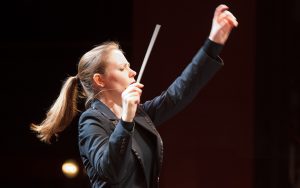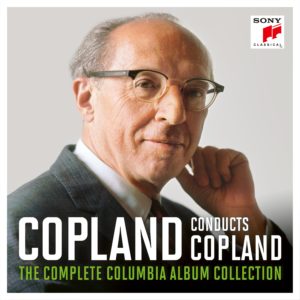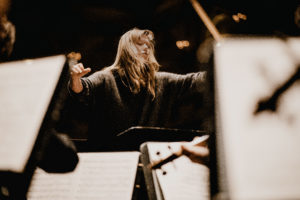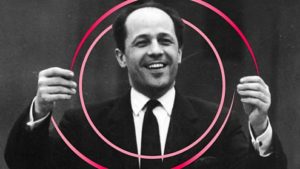
Programmers at the City of Birmingham Symphony and Hallé Orchestra served up a late birthday treat for me this week! Two concerts on consecutive nights with lots of Copland and his 20th century contemporaries. The out and out reason for me going though was to hear two of the greatest American symphonies, Samuel Barber’s pre-War Symphony No 1 and Copland’s post War Symphony No 3.
First up on Wednesday 20th was Jess Gillam’s American Road Trip at Symphony Hall in Birmingham. Conducted by the enthusiastic Jaume Santonja Espinõs, the concept here was to showcase pieces featuring the celebrated saxophonist amongst other works that represent some of the many different musical styles from the vast American continent.
Gillam’s career progression as a performer and radio and TV presenter has been stratospheric since she burst on to the scene at the BBC Young Musician of the Year in 2019. On this occasion she let her saxophone do all the talking and the CBSO supported her admirably in pieces by the Brazilian Heitor Villa Lobos (Fantasia for Saxophone) and (Scaramouche) by Darius Milhaud (who was born in France but emigrated to the US in 1940). The latter will be familiar to many as Jess’s theme tune on This Classical Life on BBC Radio 3 at Saturday lunchtime.
Most of the music in the first half was essentially composers who had composed “picture postcards” of other places. Gershwin’s Cuban Overture, Copland’s Danzón Cubano and the above works. For me though, the Villa-Lobos sounded less South American and more European. Perhaps this was because it was dedicated to the French saxophonist Marcus Mule? If I was listening blind I would have said the first part was by Finzi (summoning up a British bucolic scene) and the second and third parts by Les Six with a definite leaning towards Poulenc. It was a surprise and I enjoyed it (but then I do like Finzi and Poulenc).
The Cuban pieces were a bit rough around the edges. Beginning the concert with Cuban Overture must have been a bit daunting as it is a real whirlwind start so therefore understandable that the timing was a little out. I actually enjoyed Danzón for the odd bum note and the occasional mis timed entrance. Copland was trying to portray the warts and all mix of aspiring sophisticates and grotesquery of a Cuban dance hall with two bands playing at opposite ends of the hall. So, in actual fact, although the performance was probably a bit more earthy than the CBSO would have liked it was all the more authentic. I think Copland would have approved. Certainly, the chap behind me did chuckling at the start and the end no doubt because of the free spirited, lightness of the piece. My favourite bit is the short passage of trombone swing two thirds of the way through. Copland’s music is full of these little gifts to the different orchestral players and the CBSOs trombonists made the most of their moment in the sun.
If the concerts first half provided a kaleidoscope of orchestral colour things were about to take on a darker hue. Jess Gillam’s encore piece Duke Ellington’s In a Sentimental Mood was a very deep, velvety, dark blue played with a largo tempo (broadly or slowly) highlighting the amazing clarity of her craft. It was a fitting finale and pointed to the more subdued, staunch and sometimes troubled pieces of the second half.
After the break the CBSO played the orchestral suite version of Appalachian Spring. My first ever Copland record was Zubin Mehta and the NY Philharmonic that included Gershwin’s Cuban Overture and Appalachian Spring so it was nice all these years later to hear these pieces side by side.
The piece was well played overall. However, as often when I go to a Copland concert, if there is one instrument that struggles more than others it’s the trumpet. As usual there were a few awkward moments. I am puzzled why this should be? I wonder if it could be as a result of the trumpet part being more difficult than expected? Whether Copland’s music simply isn’t played enough and that the players aren’t familiar with the work? That perhaps there wasn’t enough rehearsal time? That Copland’s spareness of composition means that the instrument is more exposed and there is nowhere to hide? Or simply, as a frequent Copland listener (and critic) I am more likely to hear the off notes? It’s possibly a combination of all these things but I’d love to hear from a trumpeter with their views.
Regular readers of this blog will know that I love the original, 13 instrument, longer version of Appalachian Spring. However, the ending of the orchestral suite with harp harmonics and glockenspiel is a masterstroke and was delightfully played.
The concert finished with the Symphony No 1 which Samuel Barber composed in 1936 whilst living and studying in Rome. At this time there was much talk of who would produce The Great American Symphony. Barber certainly laid down a first-rate marker. It’s amazing to think this was just his Opus 9 and he was only 25 when he wrote it. It’s an incredible piece and should be programmed more often. It is highly reflective of its time and it’s almost impossible not to hear it and be reminded of the phantom menace, rise of fascism that was spreading across continental Europe at the time. It’s a 20 minute, one piece work that keeps you enwrapped the entire time. I was particularly entranced by the timpanist Matthew Hardy. The timpani part is so good that it’s almost like a mini concerto and as a result the instrument was set in a more prominent position than usual, on the left, elevated above the violins and harps. Hardy revelled in the spotlight and when he was called forward to take a bow he got the biggest cheers. I spoke to him afterwards and he said that he only played the piece for the first time the day before. I am sure that if the work was more widely known that other timpanists would be queuing up around the block to play it.
There was a delightful extra after the concert. El Ultimo Tango a quintet of flute, sax, cello, bass and piano played a 30 minute set in the Jennifer Blackwell performance space. This included one of my personal favourites – Astor Piazzolla’s Four Season of Buenos Aires Invierno Porteño (Winter). I heard this first back in Paris for another birthday celebration so it’s perfect sepia tinged romantic melancholy never fails to transform me. It was a lovely way to round off the evening.
I travelled north to the Bridgewater Hall in Manchester the following day. This concert included guest conductor Gemma New and Laura van der Heijden playing William Walton’s cello concerto.
 The concert began with Icarus a symphonic poem by Lera Auerbach. This was a completely new piece to me but one that left its mark. I love interesting orchestration and right from the beginning with the industrial sounding pizzicato double bass, driving rhythm and clever use of theremin and glass harmonica it held my interest. This said it was hard not to focus on Gemma New. The New Zealander studied at Tanglewood and you could definitely see she was from the Bernstein and Koussevitzky school of conducting! In this piece, more so than the pieces that followed, she was incredibly expressive as if she was almost living the part of Icarus. I can’t remember seeing a conductor being so much part of the performance. The “Strictly Come Conducting” probably wasn’t to all tastes but I think it really helped get the concert off to a noteworthy start.
The concert began with Icarus a symphonic poem by Lera Auerbach. This was a completely new piece to me but one that left its mark. I love interesting orchestration and right from the beginning with the industrial sounding pizzicato double bass, driving rhythm and clever use of theremin and glass harmonica it held my interest. This said it was hard not to focus on Gemma New. The New Zealander studied at Tanglewood and you could definitely see she was from the Bernstein and Koussevitzky school of conducting! In this piece, more so than the pieces that followed, she was incredibly expressive as if she was almost living the part of Icarus. I can’t remember seeing a conductor being so much part of the performance. The “Strictly Come Conducting” probably wasn’t to all tastes but I think it really helped get the concert off to a noteworthy start.
These days I make sure I listen to pieces before I go to a concert so I know what I am listening out for. I think it fair to say that apart from the middle scherzo, Walton’s Cello concerto isn’t a piece that immediately grabs you but after a few listens it gets right under your skin. Infact, with more listens I began to gain a familiarity with the slightly unnerving, almost menacing tick tocking in the first part. After the concert I realised what it reminded me of …… the Prelude from Psycho movie score by Bernhard Herrmann. It is quite uncanny how similar these pieces are in tone. The Psycho music is quicker and louder but both engender an uneasy listener experience. Interestingly, both pieces were composed at about the same time. Walton’s concerto premiered in Boston in 1957 and Psycho was released in 1960. I wonder if Herrmann was aware of the Walton? As Herrmann worked frequently and later lived in London and Walton also composed film music there is a possibility. However, there was obviously something in the air – perhaps both pieces are suggestive of a pervading Cold War foreboding? Anyway, listen for yourself and see what I mean.
Laura van der Heijden played the Cello concerto when she won the BBC Young Musician of the Year award in 2012 so it is obviously a piece close to her heart and it was superbly played throughout. At the pre-concert talk she mentioned that it isn’t programmed that much possibly because of the way it ends without the flourish you get with most concertos.
It got mixed reviews when it premiered. So did Copland’s third symphony. In fact Walton himself described Copland’s largest orchestral work as “Not my cup of tea”.
Like myself, Copland’s third was celebrating a birthday. Earlier this week it turned 75 having been premiered on October 18th 1946. As with the Walton and Barber pieces it has still not really broken through as a regular in the British orchestral repertoire. Principal cellist, Nicholas Trygstad , an American admitted at the pre-concert talk that he had never encountered the work before and that he had found out that the Hallé hadn’t played it for 30 years. He said that perhaps ones of the reasons is that it is very difficult with lots of the parts played at a very high tessitura (the highest register for a particular instrument).
Whereas, Barber’s symphony evokes the onset of war Copland’s piece (written from 1944-46) at first suggests hope and concludes with one of the most euphoric endings in the classical canon. I moved for the second half of the concert so I could get the best possible view of the woodwinds and feel the noise of the percussion and brass.
The work starts in a stately way almost like a prayer with frequent references that sound like Amen. Throughout the work there is a constant feeling of great oaks emerging from little acorns. Often the first shoots of music come from the piccolo or flute and then grow and grow to an enormous climax of full orchestra and brass and percussion battery. Most of the four parts are to some extent arc shaped so they begin as they end. The second movement scherzo has the feel of being demob happy and sprightly joie de vivre. You can feel the excitement of a joyful homecoming. The following slow movement is a complete contrast – the pianissimo violins at their highest register give an impression of a bleak landscape with the odd tumbleweed blowing past. It’s Copland at his picture painting best and a massive reality check to the previous exuberance. Perhaps it suggests that a battle had been won but the war was still ongoing?
Nevertheless, even bomb scarred terrain provides the building blocks for life and again from desolation hope germinates, this time relief coming via a lovely oboe solo. True to form, the third movement ends as it began.
The finale starts with a reorchestrated Fanfare for the Common Man. It begins with the solo flute and ends with the expected orchestral firework display. This is followed by a set of dancelike variations which get faster and faster to dizzying effect prior to a seismic crash landing. Once more the mood builds and builds and the final four minutes is one of Copland’s greatest long goodbye endings. Time and time again it feels that the crescendo has reached its zenith only for Copland to pile on even more rapturous jubilation. It is nothing short of a tour de force and the Hallé gave it the full whammy.
There was no way to stay in your seat after this amazing culmination and I gave them a standing ovation.
Principal oboist Stéphane Rancourt deserves special mention. He was picked out by Gemma New first as she went around the orchestra. His playing was sublime, even celestial and brought to my mind Gabriel’s oboe from the Ennio Morricone’s The Mission.
Hearing such a piece played by a crack orchestra and practically being on stage with them was a wonderful experience. I think the orchestra enjoyed playing it too. The sad thing was that the Bridgewater Hall was only a third full and more people didn’t get to see this excellent concert. I wanted to watch them doing it all over again and thankfully I’ll be able to as the performance was being recorded for a forthcoming online release. I really hope the people who did attend will go away and rave about it to their friends and recommend they see the video.
So, what a couple of days I had. If it was a football game it would have been a pulsating match between two giants – an El Classico perhaps with the result being a 4-4 draw but no need for a penalty shoot out! Hats off to the BSO and Hallé for the programming and the talent involved. More concerts like this please – if you have the courage to put 20th (and 21st century music) on then ultimately these and other great but relatively unknown works will fully find their place in the repertoire and into concert goers’ hearts.









Leave a Comment